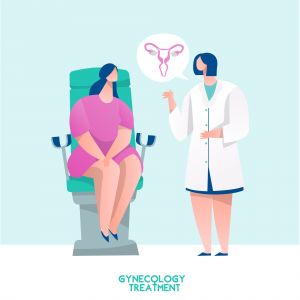What is vaginitis?
Vaginal infections are called vaginitis. Vaginitis is the general name for disorders of the vagina caused by infection, inflammation or changes in normal vaginal flora. Symptoms include vaginal discharge, odor, itching and/or discomfort. The initial evaluation typically consists of a history, physical examination, microscopy and testing for sexually transmitted infections (STIs). People whose diagnosis is confirmed in the initial assessment then receive targeted treatment. People who cannot be diagnosed or whose symptoms recur should undergo a more detailed evaluation.
How does discharge indicate infection?
Vaginal discharge is a clear sign of vaginitis, but it can be difficult to distinguish from normal vaginal discharge. The characteristics of normal vaginal discharge vary according to the hormonal status of the patient. Normal discharge may be yellowish, slightly malodorous and may be accompanied by mild irritative symptoms, but not itching, pain, burning or marked irritation, erythema, localized erosions or cervical or vaginal tightness. The absence of these signs and symptoms helps to distinguish normal vaginal discharge from discharge associated with a pathological process such as vaginitis or cervicitis.
Disruption of the normal ecosystem can lead to favorable conditions for the development of vaginitis with vaginal discharge. Some of these potentially destructive factors include sexually transmitted diseases, antibiotics, foreign body, estrogen level, use of hygienic products, pregnancy, sexual activity and choice of contraceptive method.
The most common causes of abnormal vaginal discharge are vulvovaginal candidiasis, bacterial vaginosis and trichomoniasis. These infections account for more than 90 percent of infectious vaginitis. Typically caused by sexually transmitted infections (STIs) such as gonorrhea, chlamydia and mycoplasma, cervicitis can also present as non-specific vaginal symptoms.
Non-infectious causes include a few rare conditions such as vaginal atrophy/atrophic vaginitis in postmenopausal individuals; foreign bodies (e.g. retained tampons or condoms); irritants and allergens (e.g. vaginal washing or douching); dermatoses and certain systemic medical disorders (e.g. rheumatoid arthritis and systemic lupus). A group of non-infectious etiologies can be mechanical, chemical, allergic or other.
What is candida (fungal) vaginitis?
Vulvovaginal candidiasis (VVC) is one of the most common causes of vulvovaginal itching and discharge. The disease is characterized by inflammation in the environment where Candida species are present. Treatment is indicated for symptom relief.
Certain diseases, endocrine changes and the use of medication can predispose to fungal infections.
Diabetes mellitus – Women with diabetes mellitus with poor sugar control are more prone to vulvovaginal candidiasis than women with good sugar control.
Antibiotic use – The use of broad-spectrum antibiotics significantly increases the risk of developing vulvovaginal candidiasis. One quarter to one third of women develop the disease while taking or after taking these antibiotics because the inhibition of normal bacterial flora promotes the growth of potential fungi such as Candida.
Increased estrogen levels – Vulvovaginal candidiasis is more common with increased estrogen levels, such as pregnancy and postmenopausal estrogen therapy.
Immunosuppression – Fungal infections are more common in immunocompromised patients or those with human immunodeficiency virus (HIV) infection.
Genetics – Studies of women with recurrent vulvovaginal yeast infections have found a genetic predisposition to the infection.
The treatment regimen depends on whether the woman has an uncomplicated infection (90 percent of patients) or a complicated infection (10 percent of patients). A variety of oral and topical preparations with a single-dose regimen are available for the treatment of uncomplicated vulvovaginal candidiasis. Studies assessing patient preference have consistently reported a preference for the convenience of oral therapy. However, while topical treatments have fewer side effects (e.g. possible local burning or irritation), oral medications may cause gastrointestinal intolerance, headache, rash and transient liver function abnormalities. In addition, oral medications take a day or two longer to relieve symptoms than topical treatment. The lack of superiority of any one drug and route of administration suggests that cost, patient preference and contraindications are the main considerations in the decision to prescribe an antifungal for oral or topical administration.
We recommend the use of oral fluconazole as most people find oral medicines more convenient than those administered intravaginally. Fluconazole maintains therapeutic concentrations in vaginal secretions for at least 72 hours after taking a single 150 mg tablet. Side effects of a single dose of fluconazole (150 mg) tend to be mild and infrequent. However, although fluconazole interacts with many drugs, interactions are rare at the dose used to treat vulvovaginal candidiasis.
Uncomplicated infections usually respond to treatment within a few days. There are no medical contraindications for sexual intercourse during treatment, but it may be uncomfortable until the inflammation has healed. Treatment of sexual partners is not indicated.
What is bacterial vaginitis (vaginosis)?
Bacterial vaginosis (BV) is the most common cause of abnormal vaginal discharge in women of reproductive age. Treatment aims to relieve symptoms, but many people are asymptomatic. In those who are symptomatic, abnormal vaginal discharge and fishy odor are typical.
Patients who are symptomatic, i.e. have complaints, are treated. Except for those who have had gynecological surgery, we usually do not treat other asymptomatic individuals because BV is self-limiting and self-heals in about one-third of non-pregnant women and half of pregnant women.
Patients who need treatment are treated with oral or vaginal medications. Metronidazole, clindamycin, tinidazole, seltinadazole may be given in treatment. Symptomatic pregnant women and nursing mothers should be treated. Some clinicians avoid using metronidazole in the first trimester because it crosses the placenta and therefore has the potential for teratogenicity. However, studies have shown that metronidazole use does not cause adverse effects in the fetus. The World Health Organization still does not recommend its use in the first trimester. In bacterial vaginosis, partner treatment is not recommended if the partner is asymptomatic.
Probiotics
Probiotics have been used alone and as adjunctive therapy to antibiotics for the treatment of BV and prevention of recurrence. There is no evidence against their use. Their use is recommended as they do not cause additional harm and benefits have been seen in observational studies.

